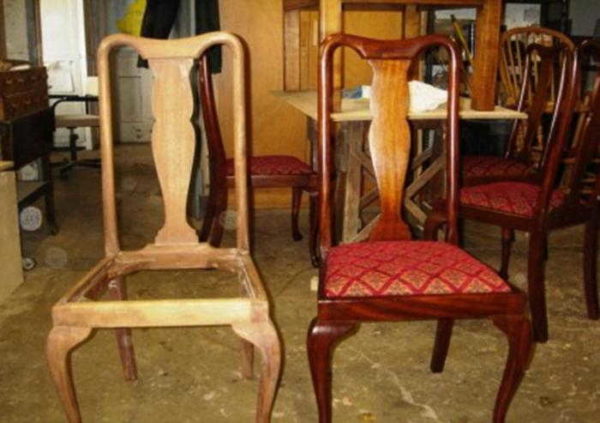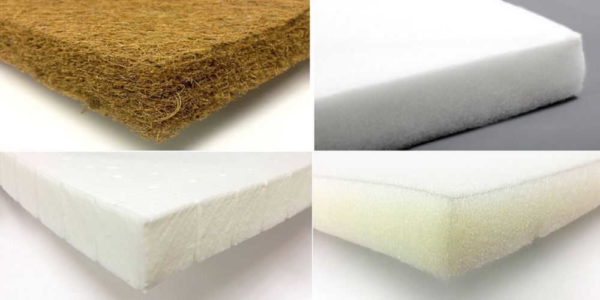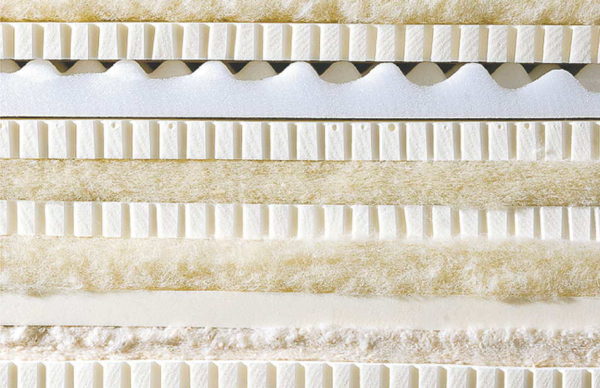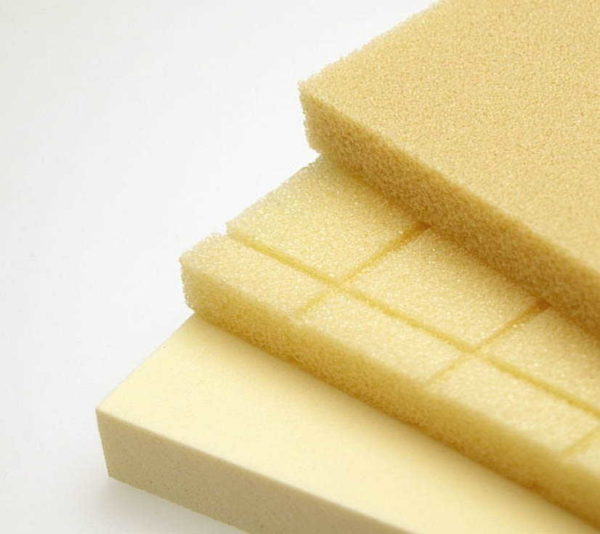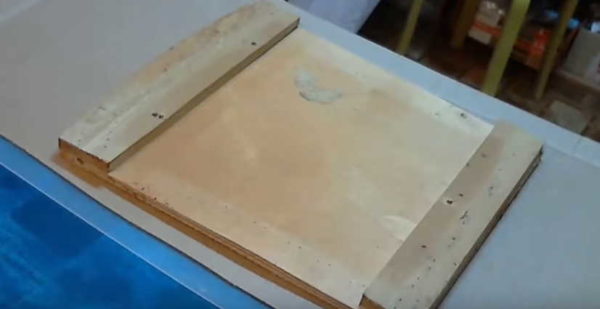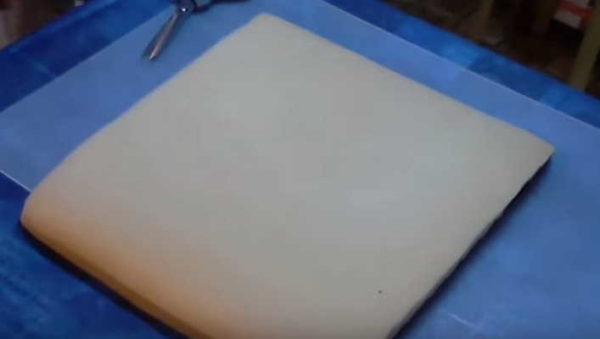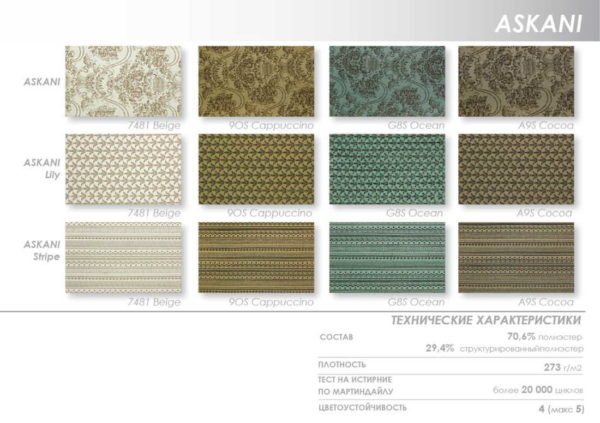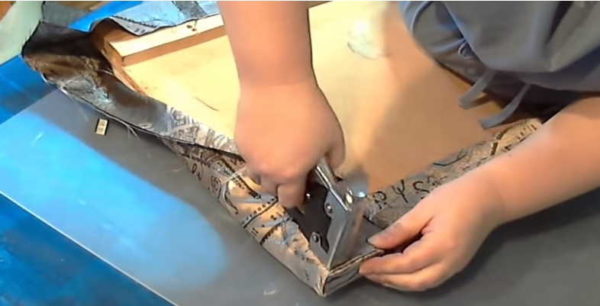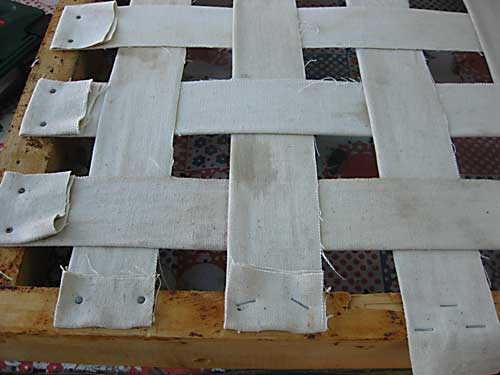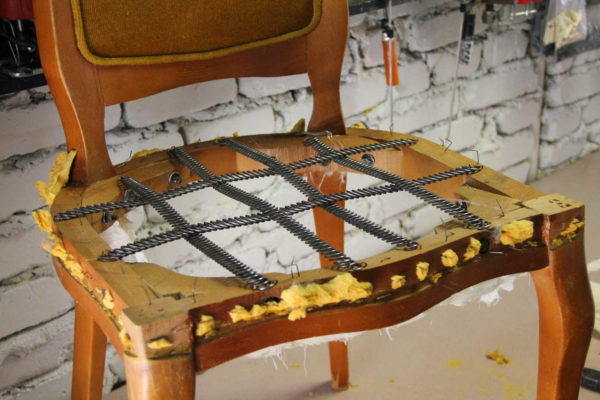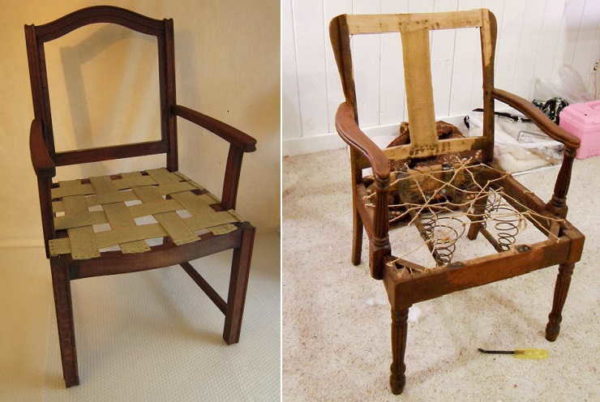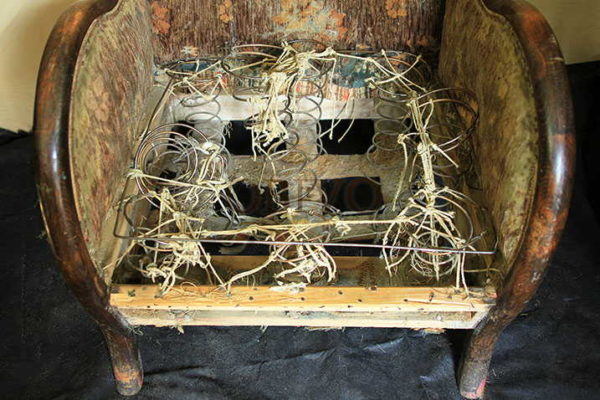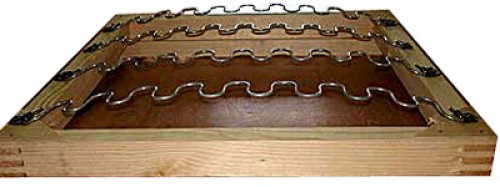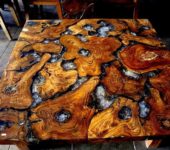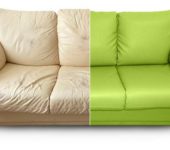Self-hauling of chairs and armchairs
Furniture, like all other things, gradually deteriorates: it begins to stagger, creak, the upholstery is wiped. It is not at all necessary to immediately run to the store - with a certain amount of effort, old furniture can be restored. Moreover, things in the style of the 60-70s are now in trend. This article will discuss how to drag a chair, what materials to use, how and what to do for what. The technique is also suitable for armchairs.
The content of the article
Steps to pull the chair
The restoration of chairs can be divided into a sequence of steps. Each of the points requires explanations, but the general algorithm of actions can be summed up in several tens of words:
- Remove upholstery and padding.
- Disassemble the frame into components.
- Assess the condition of the frame, check the connections. Disassemble unstable joints, clean, glue again.
What materials are needed for chair constriction
When restoring a chair or an armchair for the soft part, foam rubber or polyurethane foam (PPU) is used. We are talking about foamed polyurethane foam, not sheet. There is also furniture latex. It and polyurethane foam differ from foam rubber to the touch. They are more like rubber (latex is like rubber in general), when stretched / compressed they tend to return to their previous shape.
To be soft enough, the density of these materials should be 30-35 kg / m³. Foam and polyurethane foam are sold in large sheets - the minimum size is 1 * 2 meters. So enough for more than one chair. Latex is usually available in some standard sizes, but most often it is custom made.
What is better to use for chair constriction - foam rubber, latex or polyurethane foam (PPU)? If we talk about quality and durability, then latex or polyurethane foam is better. They will last up to ten years or more without signs of wear, better shock absorption and less wear and tear. The best of this pair is latex, but it is much more expensive even than polyurethane foam, not to mention foam rubber. Therefore, with a limited budget, choose foam rubber. If durability is important - polyurethane foam or latex.
Now for the thickness of these materials. For the backrest, a thickness of 3-5 cm of foam rubber / PU foam / latex is sufficient, depending on the degree of desired softness / hardness, but for the seat it is better to use materials with a thickness of 7-8 cm or more. If the base is solid - made of plywood, without springs or tapes - a thickness of 10 cm is needed. Otherwise, the base will be felt.
A synthetic winterizer is laid on top of the foam rubber. Its thickness is small - 1 cm in a free state or so. Easier to navigate by density: 150-200 g / m². This layer is needed in order to rub less foam rubber / polyurethane foam / latex. Thus, the restored upholstered furniture will last longer.
If you want the chair or chair you have pulled to serve longer, another layer of spunbond is stretched over the padding polyester - this is a non-woven material made from a polymer melt by a spunbond method. Spunbond costs quite a bit, but prolongs the life of the seat solidly. This layer is found in expensive furniture, increases durability (foam rubber / synthetic winterizer does not rub) and comfort of use (does not fidget upholstery fabric). A possible disadvantage is the build-up of static electricity.But this is only observed when used in upholstery with natural wool or silk.
How to cut and fasten
The foam is cut to fit the seat. The easiest way is to make a template at the initial stage: attach a sheet of cardboard to the seat, circle and cut. This template will be needed more than once, so it's better to make it.
We cut out foam rubber and synthetic winterizer strictly according to the template. In some cases, it is worth making it wider and longer by 3-5 mm so as not to feel the edges of the base. The cut foam rubber is glued to the base using furniture glue. There is a special glue in the can - for foam rubber. It is more convenient to use, but not easy to find everywhere.
The synthetic winterizer is placed on top - one of its sides is more "rough", so we put it on the foam rubber / polyurethane foam / latex, level it and smooth it with our hands. After that, it is problematic to separate the laid layers (you can try). If this method seems to you not reliable enough, you can glue the connection by applying a mesh of a suitable universal glue or the same foam glue.
One point: if the base of the chair is not rigid - springs, tapes, a snake - the glue should be used not the one that, after drying, is taken with a hard crust, but which remains elastic.
If you decide to use spunbond as well, it must be cut out with a margin, fastened with staples to the base, evenly straightening and stretching. It is not worth pulling too much - the material is non-woven and is easily damaged. It just needs to lie flat. We carefully trim the excess to the level of the chair / chair frame.
How to sheathe a chair: fabrics, stretching
Before you drag the chair, you will need to find the fabric. And this is not as easy as it seems: there are not just a lot of upholstery fabrics, but a lot. Moreover, it is often problematic to distinguish one material from another outwardly: not every professional can distinguish artificial suede and some types of micro-velor, chenille and jacquard are similar, sometimes velor is very similar to flock. Nevertheless, you need to have at least the slightest idea about which upholstery fabric is best for the constriction of a chair or armchair.
First of all, decide on the color scheme and type of fabric surface (fleecy or smooth). Otherwise you will be confused. Otherwise, you will have to choose "by touch." The tactile sensations should be pleasant - you need to drag the chair so that it is pleasant to use it. In the summer you will have to touch the leather upholstery. So this is an important selection criterion. Well, then, let's talk about the types of fabrics and their areas of application:
- If you have pets, it is best to pull upholstered furniture:
- Flock. It is sleek with no loops. So the claws are hard to catch and the damage is usually minimal. But not everyone likes it to the touch.
- Micro velor and velor. Also smooth fabrics with fine pile (not loops), claws just slide.
- For animals with long hair, micro velor is better - it is easier to clean.
- If there are small children in the house, the fabrics should be easy to clean. These are flock, micro-velor, artificial leather.
- Tapestry and jacquard are also good. They differ in weave. Usually they have a solid or colored pattern. If you need to pull the chair under the classic interior, your choice is tapestry or jacquard.
The rest of the fabrics can also be used if you like. But they are less practical than those listed above. In any case, you need to pay attention to the density of the fabric. Normal upholstery fabric should have a density of at least 200-250 g / m², as well as high abrasion resistance (15-20 thousand abrasion cycles). These specifications can be found in the fabric specification or check with your retailer.
How to pull a chair: tighten the belts
You usually don't need to sew anything for the back or seat of a chair.All you need to do is cut a piece of fabric of a suitable shape with stretching allowances. Then we proceed like this:
- We fix it in front, tighten it and fasten it in the back. We install both fasteners in the center.
- We stretch and fasten on the right and left - in the center.
- Then we stretch the fabric evenly, fix it alternately on the right and left.
- Also alternately in front, behind.
The main thing is uniform tension without wrinkles. The fabric is usually fixed with staples, placing them at a distance of 3-5 cm from each other. The staples hold the fabric well enough, do not pierce it. If there are indications that they will break through the surface, the force of the impact should be reduced.
The second option is to use small carnations. A dense tape is needed under them - just so as not to break through the fabric. Nails are a good solution, but they take more time to tighten the chair. When using nails, they should not be too long, so that they do not stick out from the back side and do not tear the foam rubber.
Base with straps or snake spring: features
Chairs and armchairs can be made with a wooden frame to which ribbons or snake springs are attached. For very old chairs / armchairs, the ribbons may be inelastic - just a dense strip of tarpaulin or similar material, new chairs are made with synthetic ribbons with "elastic bands". They are attached to the frame with nails (old furniture) or staples (modern). When fastening with nails, a strip of dense fabric is laid under the fasteners; usually nothing is put under the staples.
When restoring a chair or chair, it is advisable to use a tape of the same width or close to it. This will keep the number of transverse and longitudinal stripes. This is if the previous "bearing" capacity of the seat suits you. If it was uncomfortable, you can either increase the width of the belts, or put more strips. Or you can do both at once.
The distance between belts is considered to be normal about 30 mm. It can be a little more / less, but not much more.
You can use either an elastic furniture tape, or just a dense one, such as slings or towing tapes. Elastic will "act out" when landing, rigid - no. But this does not mean that it will be uncomfortable to sit. Softness is provided by foam rubber and related materials, and straps / springs only soften the fit. Therefore, if you have an old chair or chair with springs and need to be restored, it is easier and cheaper to replace them with ribbons.
By the softness of the landing, they will be a little harder, but not so much that it is worth fiddling with the constriction of the springs. If desired, you can put snake springs. They also give elasticity, albeit less than traditional ones.
How to fasten and with what force to pull
Belts are attached to the frame, approximately in the middle of the bar. Take the tape, fasten it with three or four staples in the opposite direction, wrap it up and fasten it again. Then they stretch and fasten on the other side. This is a reliable way. And do not be embarrassed that the attachment point is thick. Foam rubber will be laid on top, it levels out all these little things.
Now about how hard to pull the elastic bands. The tensile force on the seat should be 12 kg, on the backrest - 9 kg. In practice, the preset tension can be set using the balance:
- We fasten one side of the tape.
- For the second side of the tape we hook the steelyard hook and pull it until the desired number is on the dial.
- Using a marker, put a mark.
- Now we know how long the tape needs to be pulled in order to obtain the desired tension.
This procedure will have to be repeated with transverse and longitudinal stripes. And if the shape of the seat or back is uneven, then each strip will have to be calibrated in this way. And one more thing: when you cut it off, do not forget about the fact that the tape still needs to be tucked up and fixed.That is, from the mark, you still need to leave 3-5 cm - for the turn.
If you think you can pull the tape just by holding it with your hands, you are wrong. Men with strong fingers can still cope, but women are unlikely to succeed in this trick. Professionals use a special tool, but buying it for the sake of constricting a pair of chairs is hardly worth it. Specialty stores have grippers for tapes with holes. It is much more convenient with them, and you can hook a steelyard hook to the hole.
The second option is to take a wooden block with a section of 40 * 40 mm or so, 40-50 cm long.Fix medium to fine sandpaper on the central part. We glue the emery and additionally fix it with staples (or nails). Leave the edges of the bar - 15 centimeters each - free. These will be handles. We wind the tape on this device (a couple of turns), take it with both hands and pull.
Snake springs
Flat springs-snakes are of different types - in the form of a spiral made of thinner wire or actually in the form of a "snake" of thicker steel. You can also drag the chair with their help. In armchairs and chairs, they are usually attached along the seat. They are fixed to the frame using special fasteners, and they are fixed with nails or brackets with long legs. In the normal state, the snake is slightly curved towards the future load (as in the photo).
By its properties, the chair "with snakes" turns out to be slightly more elastic when seated than with ribbons. Otherwise, there are almost no differences.
Features of a pie with ribbons or springs
If you need to drag a chair with ribbons or snakes at the base, a layer of fabric is placed between them and the foam rubber. Fabric - any dense. Teak or similar material will do. This layer protects the foam / polyurethane foam / latex from premature chafing. It has no other functions.
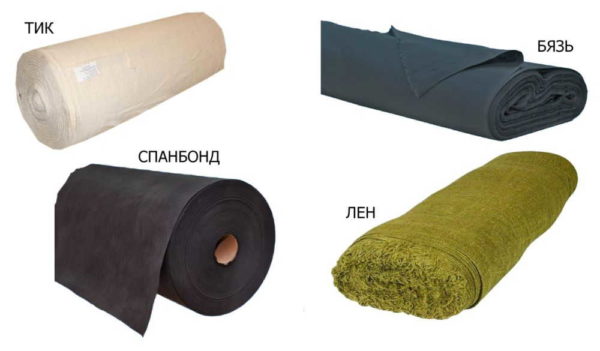
Technical fabrics that are used when they want to pull a chair: teak, coarse calico, spunbond, linen
A layer of this fabric is glued to the bottom of the foam rubber. The dimensions of the fabric can be slightly larger so that the edges do not wrap. Otherwise, the layers of the soft part of the stool are similar.
- If you have pets, it is best to pull upholstered furniture:

